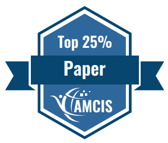Advances in Information Systems (General Track)
Loading...
Paper Type
Complete
Paper Number
1513
Description
All organizations execute business processes (BP). Much of current BP literature address modeling, increasing effectiveness, or increasing efficiency. We argue the first discussion should be assessing knowledge of one’s primary BP. We present the theoretical defense and test results supporting validity and measure development of a new individual level construct titled Perceived Business Process Knowledge (PBPK). SmartPLS was used to evaluate the measurement and structural models. The initial instrument contained 31 reflective indicators representing the 6 PBPK dimensions. The 6 dimensions were modeled as formative with respect to the focal construct. We tested for predictive ability against 2 UTAUT factors, specifically Performance Expectancy and Facilitating Conditions. The model assessed using two samples, 487 and 364 responses, each representing 22 and 3 industries, respectively. The PBPK construct is proposed to increase the explanatory and predictive ability of technology acceptance models and may help in systems development and business process improvement efforts.
Recommended Citation
Angeles, Jose and Guzman, Indira, "Did we miss it? Perceived Business Process Knowledge, a Critical Antecedent of Effective use of Information Systems" (2021). AMCIS 2021 Proceedings. 15.
https://aisel.aisnet.org/amcis2021/adv_info_systems_general_track/adv_info_systems_general_track/15
Did we miss it? Perceived Business Process Knowledge, a Critical Antecedent of Effective use of Information Systems
All organizations execute business processes (BP). Much of current BP literature address modeling, increasing effectiveness, or increasing efficiency. We argue the first discussion should be assessing knowledge of one’s primary BP. We present the theoretical defense and test results supporting validity and measure development of a new individual level construct titled Perceived Business Process Knowledge (PBPK). SmartPLS was used to evaluate the measurement and structural models. The initial instrument contained 31 reflective indicators representing the 6 PBPK dimensions. The 6 dimensions were modeled as formative with respect to the focal construct. We tested for predictive ability against 2 UTAUT factors, specifically Performance Expectancy and Facilitating Conditions. The model assessed using two samples, 487 and 364 responses, each representing 22 and 3 industries, respectively. The PBPK construct is proposed to increase the explanatory and predictive ability of technology acceptance models and may help in systems development and business process improvement efforts.
When commenting on articles, please be friendly, welcoming, respectful and abide by the AIS eLibrary Discussion Thread Code of Conduct posted here.



